Valuation Models & Investment Banks: Impact on M&A Transactions
VerifiedAdded on 2023/06/15
|8
|2011
|467
Report
AI Summary
This report provides a critical evaluation of the role of valuation models in framing seller's price anticipation during mergers and acquisitions. It assesses the influence of factors like cash flow, time value of money, and synergy on valuation. The report also examines the roles played by investment banks as both seller-side and buyer-side advisors, highlighting their responsibilities in valuation, market analysis, and facilitating transactions. It concludes by emphasizing the importance of understanding these dynamics for business executives and financial advisors involved in M&A decisions.

Running head: FINANCE
Finance
Name of the Student
Name of the University
Authors Note
Course ID
Finance
Name of the Student
Name of the University
Authors Note
Course ID
Paraphrase This Document
Need a fresh take? Get an instant paraphrase of this document with our AI Paraphraser
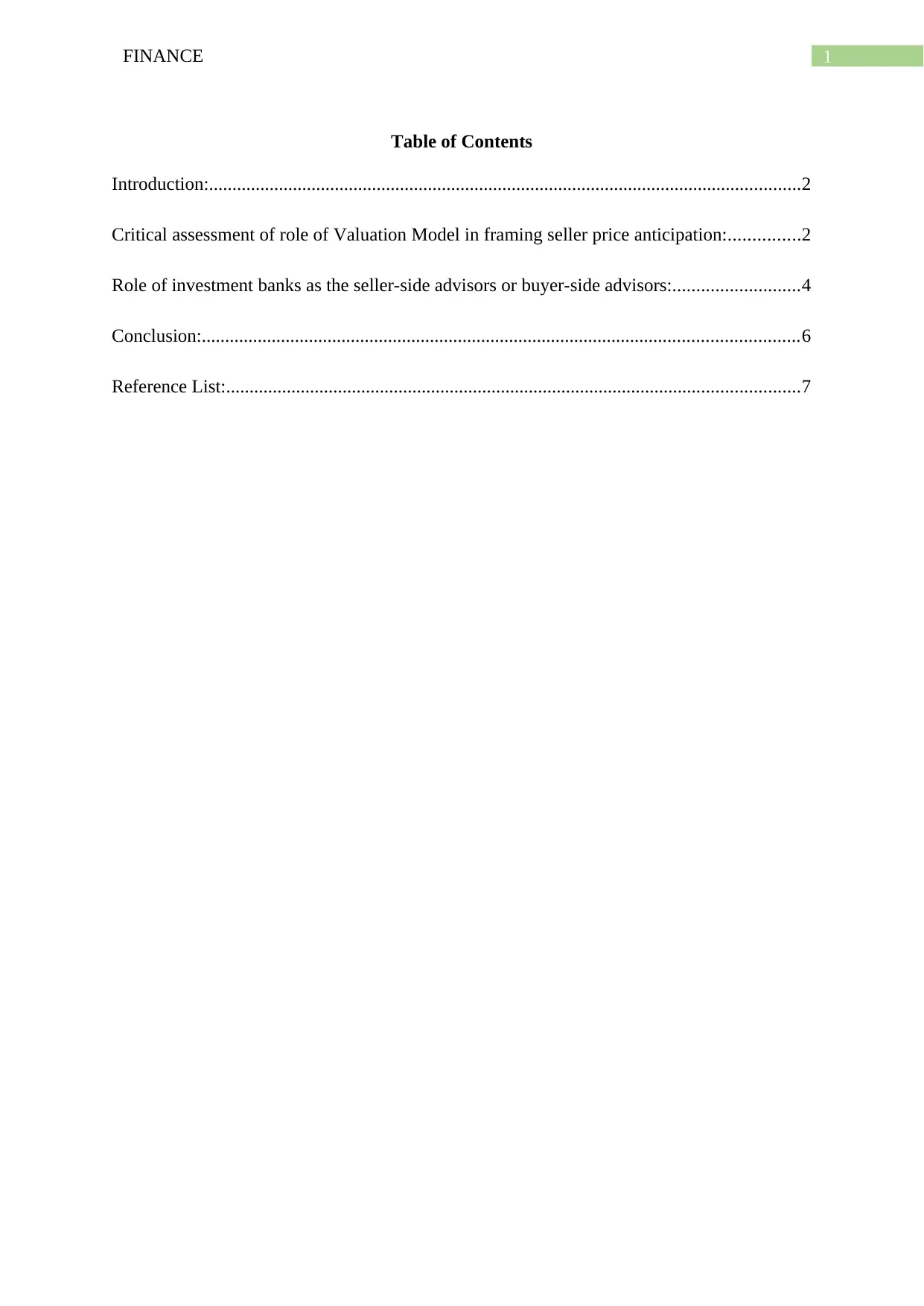
1FINANCE
Table of Contents
Introduction:...............................................................................................................................2
Critical assessment of role of Valuation Model in framing seller price anticipation:...............2
Role of investment banks as the seller-side advisors or buyer-side advisors:...........................4
Conclusion:................................................................................................................................6
Reference List:...........................................................................................................................7
Table of Contents
Introduction:...............................................................................................................................2
Critical assessment of role of Valuation Model in framing seller price anticipation:...............2
Role of investment banks as the seller-side advisors or buyer-side advisors:...........................4
Conclusion:................................................................................................................................6
Reference List:...........................................................................................................................7

2FINANCE
Introduction:
In the process of merger and acquisition transaction, valuation represents the price
where a party to the transaction would pay for the other or the value that other party will give
up to make the transaction work. Valuation is made through the appraisal or in other words
the price of the organization’s stock given that it is a public company. However, at the end of
the valuation represents the number which is regularly negotiated. The current report is based
on critical evaluation of the role of valuation model at the time of framing the seller’s price
anticipation during mergers and acquisition. Additionally, the report will assess the role
played by the investment banks as the seller-side advisors and the buyer side advisors.
Critical assessment of role of Valuation Model in framing seller price anticipation:
Valuation is generally regarded as the blend of cash flow and the time value of
money. The value of the business is represented in two parts namely the profits and cash flow
generated by it. With several financial transactions, the time value of the money is one of the
factor. The valuation model takes into the account the amount the buyer is willing to pay and
the rate of interest they must discount the other company future cash flows (Cartwright and
Cooper 2014). Both the buyer and seller in the mergers and acquisition will possess different
perception regarding the worth of the target firm. It is the sellers that would tend to value the
firm at a price as high as possible where the buyer would try to obtain the at the lowest price
possible.
An important assertion can be bought forward by stating that the value of the
company is different from the price at which the firm is sold. Price represents the value at
which the willing purchaser and the seller is would agree to transact the deal. The value of the
company is perceived as the factor that impacts the price anticipation of the seller and buyer.
Introduction:
In the process of merger and acquisition transaction, valuation represents the price
where a party to the transaction would pay for the other or the value that other party will give
up to make the transaction work. Valuation is made through the appraisal or in other words
the price of the organization’s stock given that it is a public company. However, at the end of
the valuation represents the number which is regularly negotiated. The current report is based
on critical evaluation of the role of valuation model at the time of framing the seller’s price
anticipation during mergers and acquisition. Additionally, the report will assess the role
played by the investment banks as the seller-side advisors and the buyer side advisors.
Critical assessment of role of Valuation Model in framing seller price anticipation:
Valuation is generally regarded as the blend of cash flow and the time value of
money. The value of the business is represented in two parts namely the profits and cash flow
generated by it. With several financial transactions, the time value of the money is one of the
factor. The valuation model takes into the account the amount the buyer is willing to pay and
the rate of interest they must discount the other company future cash flows (Cartwright and
Cooper 2014). Both the buyer and seller in the mergers and acquisition will possess different
perception regarding the worth of the target firm. It is the sellers that would tend to value the
firm at a price as high as possible where the buyer would try to obtain the at the lowest price
possible.
An important assertion can be bought forward by stating that the value of the
company is different from the price at which the firm is sold. Price represents the value at
which the willing purchaser and the seller is would agree to transact the deal. The value of the
company is perceived as the factor that impacts the price anticipation of the seller and buyer.
⊘ This is a preview!⊘
Do you want full access?
Subscribe today to unlock all pages.

Trusted by 1+ million students worldwide
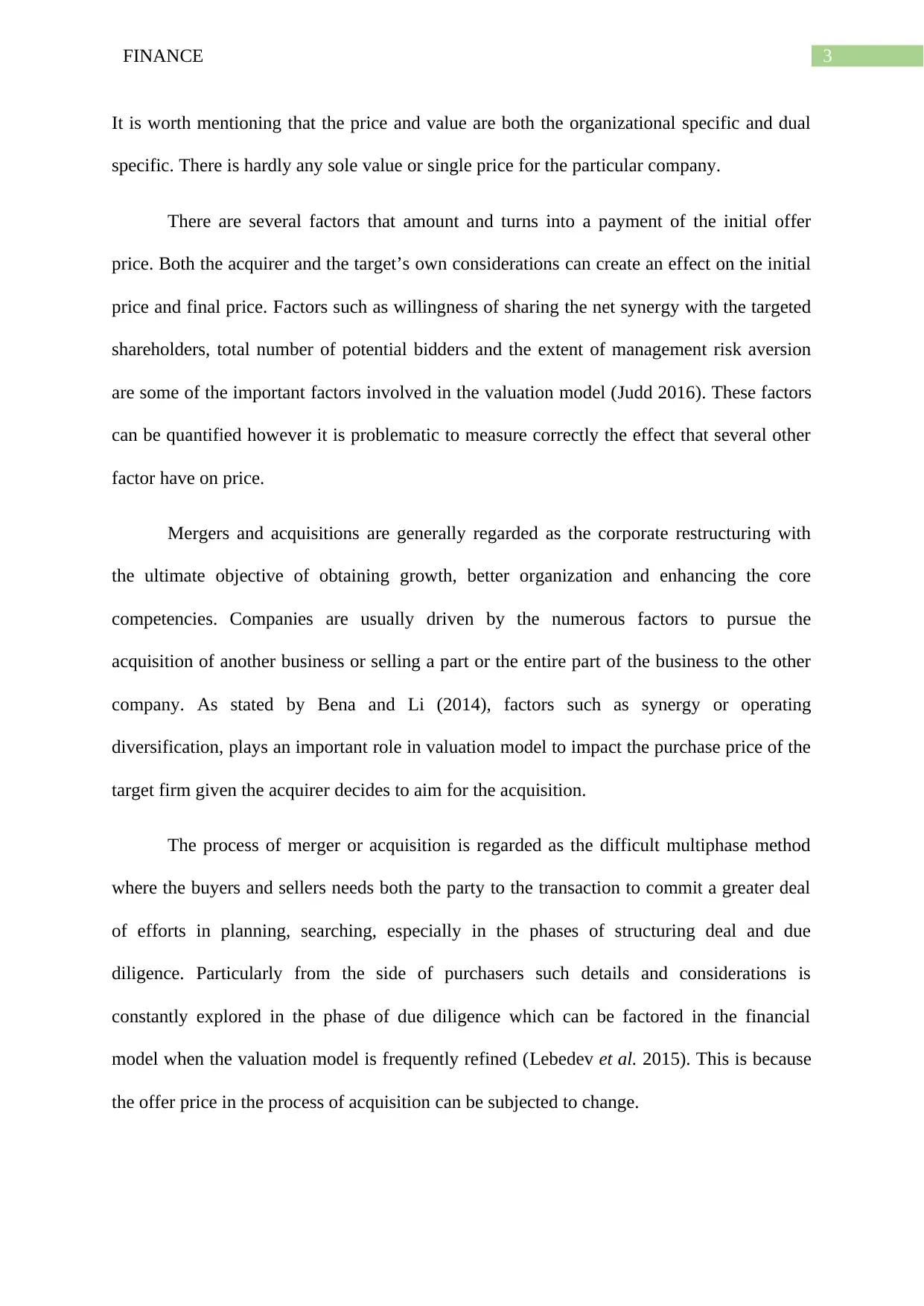
3FINANCE
It is worth mentioning that the price and value are both the organizational specific and dual
specific. There is hardly any sole value or single price for the particular company.
There are several factors that amount and turns into a payment of the initial offer
price. Both the acquirer and the target’s own considerations can create an effect on the initial
price and final price. Factors such as willingness of sharing the net synergy with the targeted
shareholders, total number of potential bidders and the extent of management risk aversion
are some of the important factors involved in the valuation model (Judd 2016). These factors
can be quantified however it is problematic to measure correctly the effect that several other
factor have on price.
Mergers and acquisitions are generally regarded as the corporate restructuring with
the ultimate objective of obtaining growth, better organization and enhancing the core
competencies. Companies are usually driven by the numerous factors to pursue the
acquisition of another business or selling a part or the entire part of the business to the other
company. As stated by Bena and Li (2014), factors such as synergy or operating
diversification, plays an important role in valuation model to impact the purchase price of the
target firm given the acquirer decides to aim for the acquisition.
The process of merger or acquisition is regarded as the difficult multiphase method
where the buyers and sellers needs both the party to the transaction to commit a greater deal
of efforts in planning, searching, especially in the phases of structuring deal and due
diligence. Particularly from the side of purchasers such details and considerations is
constantly explored in the phase of due diligence which can be factored in the financial
model when the valuation model is frequently refined (Lebedev et al. 2015). This is because
the offer price in the process of acquisition can be subjected to change.
It is worth mentioning that the price and value are both the organizational specific and dual
specific. There is hardly any sole value or single price for the particular company.
There are several factors that amount and turns into a payment of the initial offer
price. Both the acquirer and the target’s own considerations can create an effect on the initial
price and final price. Factors such as willingness of sharing the net synergy with the targeted
shareholders, total number of potential bidders and the extent of management risk aversion
are some of the important factors involved in the valuation model (Judd 2016). These factors
can be quantified however it is problematic to measure correctly the effect that several other
factor have on price.
Mergers and acquisitions are generally regarded as the corporate restructuring with
the ultimate objective of obtaining growth, better organization and enhancing the core
competencies. Companies are usually driven by the numerous factors to pursue the
acquisition of another business or selling a part or the entire part of the business to the other
company. As stated by Bena and Li (2014), factors such as synergy or operating
diversification, plays an important role in valuation model to impact the purchase price of the
target firm given the acquirer decides to aim for the acquisition.
The process of merger or acquisition is regarded as the difficult multiphase method
where the buyers and sellers needs both the party to the transaction to commit a greater deal
of efforts in planning, searching, especially in the phases of structuring deal and due
diligence. Particularly from the side of purchasers such details and considerations is
constantly explored in the phase of due diligence which can be factored in the financial
model when the valuation model is frequently refined (Lebedev et al. 2015). This is because
the offer price in the process of acquisition can be subjected to change.
Paraphrase This Document
Need a fresh take? Get an instant paraphrase of this document with our AI Paraphraser
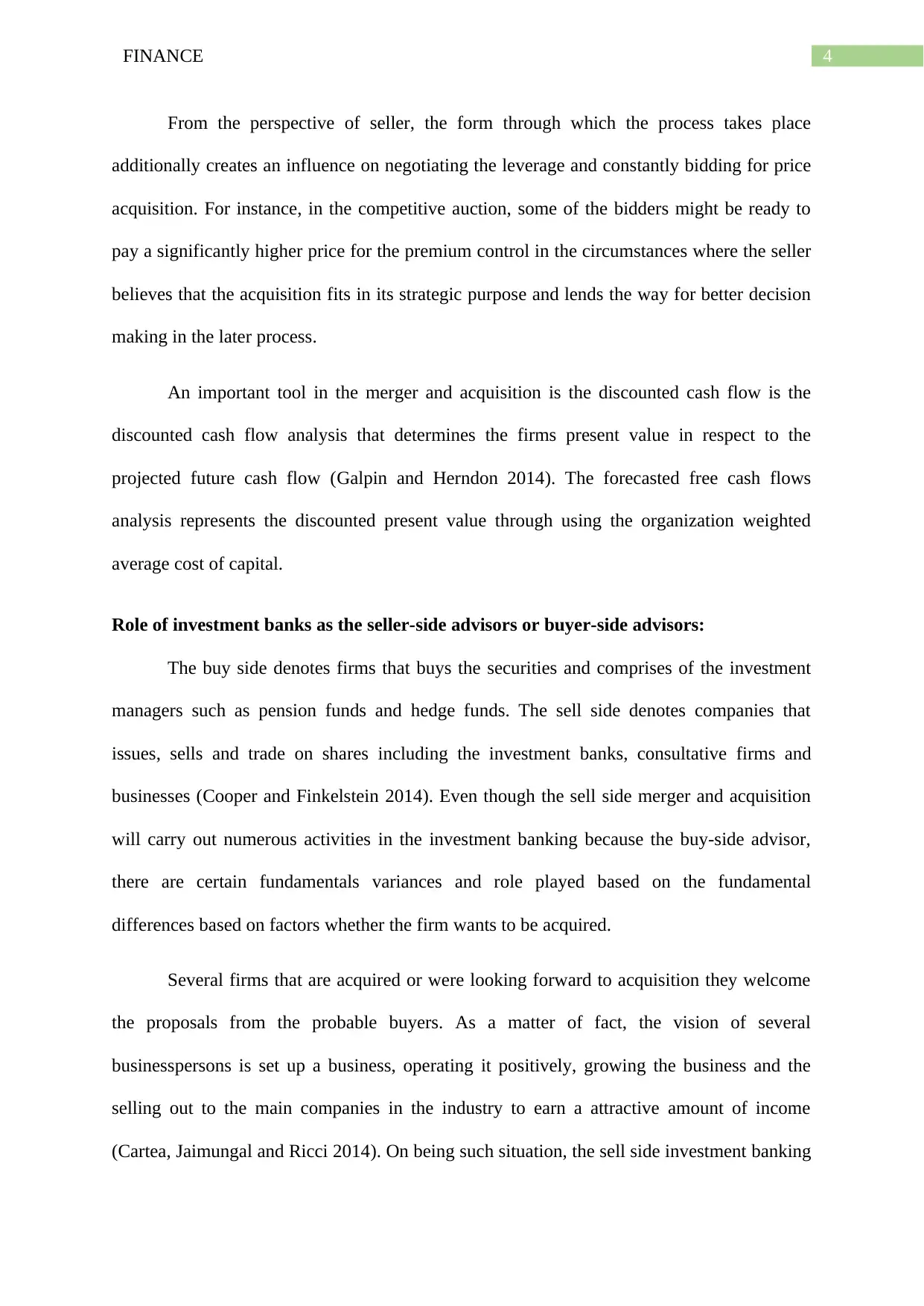
4FINANCE
From the perspective of seller, the form through which the process takes place
additionally creates an influence on negotiating the leverage and constantly bidding for price
acquisition. For instance, in the competitive auction, some of the bidders might be ready to
pay a significantly higher price for the premium control in the circumstances where the seller
believes that the acquisition fits in its strategic purpose and lends the way for better decision
making in the later process.
An important tool in the merger and acquisition is the discounted cash flow is the
discounted cash flow analysis that determines the firms present value in respect to the
projected future cash flow (Galpin and Herndon 2014). The forecasted free cash flows
analysis represents the discounted present value through using the organization weighted
average cost of capital.
Role of investment banks as the seller-side advisors or buyer-side advisors:
The buy side denotes firms that buys the securities and comprises of the investment
managers such as pension funds and hedge funds. The sell side denotes companies that
issues, sells and trade on shares including the investment banks, consultative firms and
businesses (Cooper and Finkelstein 2014). Even though the sell side merger and acquisition
will carry out numerous activities in the investment banking because the buy-side advisor,
there are certain fundamentals variances and role played based on the fundamental
differences based on factors whether the firm wants to be acquired.
Several firms that are acquired or were looking forward to acquisition they welcome
the proposals from the probable buyers. As a matter of fact, the vision of several
businesspersons is set up a business, operating it positively, growing the business and the
selling out to the main companies in the industry to earn a attractive amount of income
(Cartea, Jaimungal and Ricci 2014). On being such situation, the sell side investment banking
From the perspective of seller, the form through which the process takes place
additionally creates an influence on negotiating the leverage and constantly bidding for price
acquisition. For instance, in the competitive auction, some of the bidders might be ready to
pay a significantly higher price for the premium control in the circumstances where the seller
believes that the acquisition fits in its strategic purpose and lends the way for better decision
making in the later process.
An important tool in the merger and acquisition is the discounted cash flow is the
discounted cash flow analysis that determines the firms present value in respect to the
projected future cash flow (Galpin and Herndon 2014). The forecasted free cash flows
analysis represents the discounted present value through using the organization weighted
average cost of capital.
Role of investment banks as the seller-side advisors or buyer-side advisors:
The buy side denotes firms that buys the securities and comprises of the investment
managers such as pension funds and hedge funds. The sell side denotes companies that
issues, sells and trade on shares including the investment banks, consultative firms and
businesses (Cooper and Finkelstein 2014). Even though the sell side merger and acquisition
will carry out numerous activities in the investment banking because the buy-side advisor,
there are certain fundamentals variances and role played based on the fundamental
differences based on factors whether the firm wants to be acquired.
Several firms that are acquired or were looking forward to acquisition they welcome
the proposals from the probable buyers. As a matter of fact, the vision of several
businesspersons is set up a business, operating it positively, growing the business and the
selling out to the main companies in the industry to earn a attractive amount of income
(Cartea, Jaimungal and Ricci 2014). On being such situation, the sell side investment banking
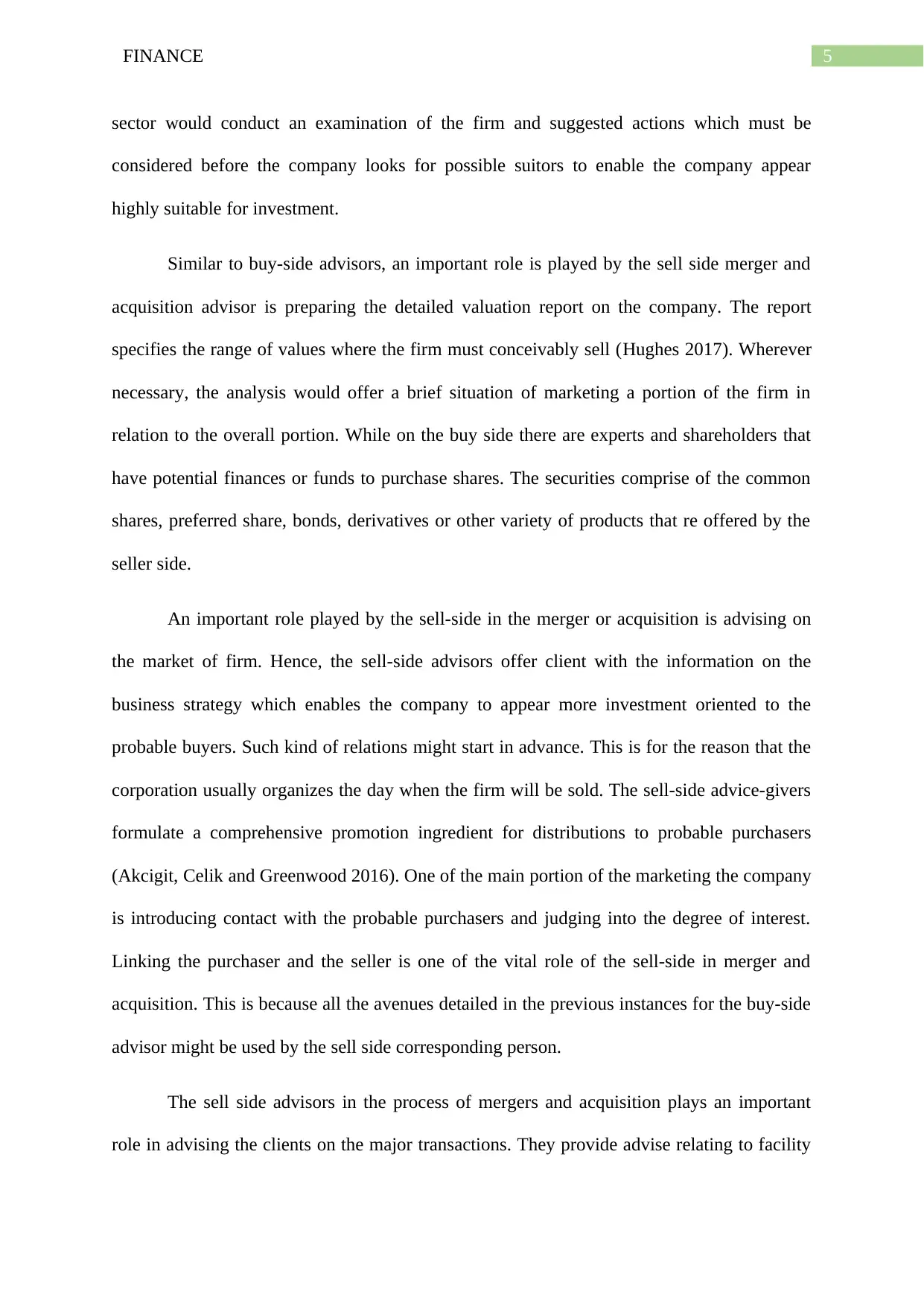
5FINANCE
sector would conduct an examination of the firm and suggested actions which must be
considered before the company looks for possible suitors to enable the company appear
highly suitable for investment.
Similar to buy-side advisors, an important role is played by the sell side merger and
acquisition advisor is preparing the detailed valuation report on the company. The report
specifies the range of values where the firm must conceivably sell (Hughes 2017). Wherever
necessary, the analysis would offer a brief situation of marketing a portion of the firm in
relation to the overall portion. While on the buy side there are experts and shareholders that
have potential finances or funds to purchase shares. The securities comprise of the common
shares, preferred share, bonds, derivatives or other variety of products that re offered by the
seller side.
An important role played by the sell-side in the merger or acquisition is advising on
the market of firm. Hence, the sell-side advisors offer client with the information on the
business strategy which enables the company to appear more investment oriented to the
probable buyers. Such kind of relations might start in advance. This is for the reason that the
corporation usually organizes the day when the firm will be sold. The sell-side advice-givers
formulate a comprehensive promotion ingredient for distributions to probable purchasers
(Akcigit, Celik and Greenwood 2016). One of the main portion of the marketing the company
is introducing contact with the probable purchasers and judging into the degree of interest.
Linking the purchaser and the seller is one of the vital role of the sell-side in merger and
acquisition. This is because all the avenues detailed in the previous instances for the buy-side
advisor might be used by the sell side corresponding person.
The sell side advisors in the process of mergers and acquisition plays an important
role in advising the clients on the major transactions. They provide advise relating to facility
sector would conduct an examination of the firm and suggested actions which must be
considered before the company looks for possible suitors to enable the company appear
highly suitable for investment.
Similar to buy-side advisors, an important role is played by the sell side merger and
acquisition advisor is preparing the detailed valuation report on the company. The report
specifies the range of values where the firm must conceivably sell (Hughes 2017). Wherever
necessary, the analysis would offer a brief situation of marketing a portion of the firm in
relation to the overall portion. While on the buy side there are experts and shareholders that
have potential finances or funds to purchase shares. The securities comprise of the common
shares, preferred share, bonds, derivatives or other variety of products that re offered by the
seller side.
An important role played by the sell-side in the merger or acquisition is advising on
the market of firm. Hence, the sell-side advisors offer client with the information on the
business strategy which enables the company to appear more investment oriented to the
probable buyers. Such kind of relations might start in advance. This is for the reason that the
corporation usually organizes the day when the firm will be sold. The sell-side advice-givers
formulate a comprehensive promotion ingredient for distributions to probable purchasers
(Akcigit, Celik and Greenwood 2016). One of the main portion of the marketing the company
is introducing contact with the probable purchasers and judging into the degree of interest.
Linking the purchaser and the seller is one of the vital role of the sell-side in merger and
acquisition. This is because all the avenues detailed in the previous instances for the buy-side
advisor might be used by the sell side corresponding person.
The sell side advisors in the process of mergers and acquisition plays an important
role in advising the clients on the major transactions. They provide advise relating to facility
⊘ This is a preview!⊘
Do you want full access?
Subscribe today to unlock all pages.

Trusted by 1+ million students worldwide

6FINANCE
of raising capital fund together with the cost of debt and equity. The sell side advisor provide
advice on the merger and acquisition (Davis and Lleo 2015). The sell side advisor helps in
creating liquidity for the listed shares and additionally aid customers in getting in and out of
the situations.
The buy side advisor plays an important role in managing the money of client and
providing advice relating to making decision on buy, hold and sell. The buy side advisor
provides advice relating to earning from the return on capital from the best adjusted risk. The
buy-side advisor carryout the in house research on the investment opportunities and carry out
the financial modelling and valuation.
Overall it can be stated that during the procedure of merger and acquisition it is not
common for selling the company to initiate the action. Characteristically, the seller hires the
third party financial institution advisor for securing its goal.
Conclusion:
On a conclusive note, the analysis provides a comprehensive understanding of the
merger and acquisition in context of both the acquiring company and the perspective of the
target company. The critical analysis provides the framework to any business executive,
financial advisor or investment banker that have to undertake decision on the issues of merger
and acquisition issue. The critical analysis provides the readers with the overall picture with
factors and determinants that create an impact on the valuation and negotiation of purchase
price.
of raising capital fund together with the cost of debt and equity. The sell side advisor provide
advice on the merger and acquisition (Davis and Lleo 2015). The sell side advisor helps in
creating liquidity for the listed shares and additionally aid customers in getting in and out of
the situations.
The buy side advisor plays an important role in managing the money of client and
providing advice relating to making decision on buy, hold and sell. The buy side advisor
provides advice relating to earning from the return on capital from the best adjusted risk. The
buy-side advisor carryout the in house research on the investment opportunities and carry out
the financial modelling and valuation.
Overall it can be stated that during the procedure of merger and acquisition it is not
common for selling the company to initiate the action. Characteristically, the seller hires the
third party financial institution advisor for securing its goal.
Conclusion:
On a conclusive note, the analysis provides a comprehensive understanding of the
merger and acquisition in context of both the acquiring company and the perspective of the
target company. The critical analysis provides the framework to any business executive,
financial advisor or investment banker that have to undertake decision on the issues of merger
and acquisition issue. The critical analysis provides the readers with the overall picture with
factors and determinants that create an impact on the valuation and negotiation of purchase
price.
Paraphrase This Document
Need a fresh take? Get an instant paraphrase of this document with our AI Paraphraser
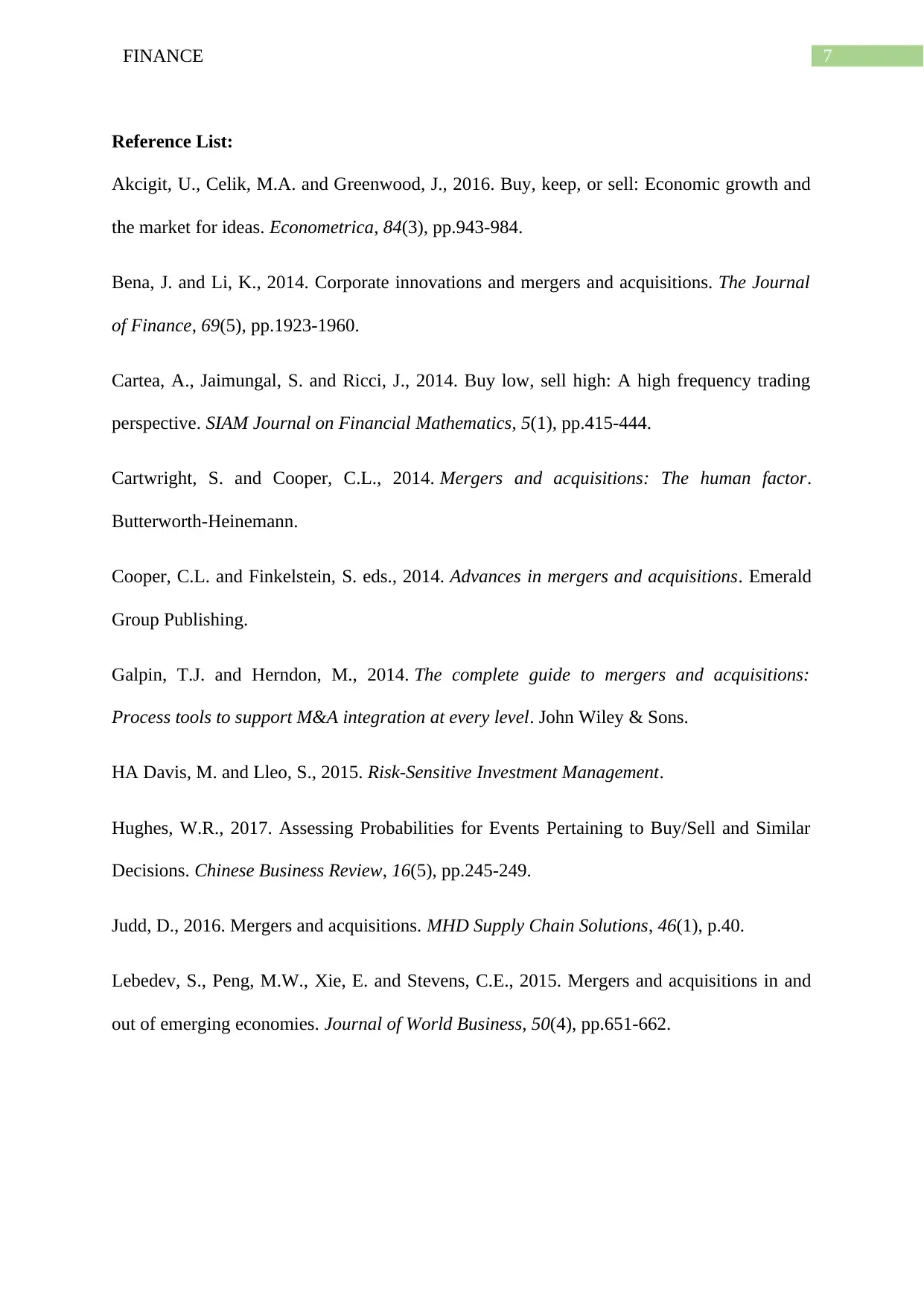
7FINANCE
Reference List:
Akcigit, U., Celik, M.A. and Greenwood, J., 2016. Buy, keep, or sell: Economic growth and
the market for ideas. Econometrica, 84(3), pp.943-984.
Bena, J. and Li, K., 2014. Corporate innovations and mergers and acquisitions. The Journal
of Finance, 69(5), pp.1923-1960.
Cartea, A., Jaimungal, S. and Ricci, J., 2014. Buy low, sell high: A high frequency trading
perspective. SIAM Journal on Financial Mathematics, 5(1), pp.415-444.
Cartwright, S. and Cooper, C.L., 2014. Mergers and acquisitions: The human factor.
Butterworth-Heinemann.
Cooper, C.L. and Finkelstein, S. eds., 2014. Advances in mergers and acquisitions. Emerald
Group Publishing.
Galpin, T.J. and Herndon, M., 2014. The complete guide to mergers and acquisitions:
Process tools to support M&A integration at every level. John Wiley & Sons.
HA Davis, M. and Lleo, S., 2015. Risk-Sensitive Investment Management.
Hughes, W.R., 2017. Assessing Probabilities for Events Pertaining to Buy/Sell and Similar
Decisions. Chinese Business Review, 16(5), pp.245-249.
Judd, D., 2016. Mergers and acquisitions. MHD Supply Chain Solutions, 46(1), p.40.
Lebedev, S., Peng, M.W., Xie, E. and Stevens, C.E., 2015. Mergers and acquisitions in and
out of emerging economies. Journal of World Business, 50(4), pp.651-662.
Reference List:
Akcigit, U., Celik, M.A. and Greenwood, J., 2016. Buy, keep, or sell: Economic growth and
the market for ideas. Econometrica, 84(3), pp.943-984.
Bena, J. and Li, K., 2014. Corporate innovations and mergers and acquisitions. The Journal
of Finance, 69(5), pp.1923-1960.
Cartea, A., Jaimungal, S. and Ricci, J., 2014. Buy low, sell high: A high frequency trading
perspective. SIAM Journal on Financial Mathematics, 5(1), pp.415-444.
Cartwright, S. and Cooper, C.L., 2014. Mergers and acquisitions: The human factor.
Butterworth-Heinemann.
Cooper, C.L. and Finkelstein, S. eds., 2014. Advances in mergers and acquisitions. Emerald
Group Publishing.
Galpin, T.J. and Herndon, M., 2014. The complete guide to mergers and acquisitions:
Process tools to support M&A integration at every level. John Wiley & Sons.
HA Davis, M. and Lleo, S., 2015. Risk-Sensitive Investment Management.
Hughes, W.R., 2017. Assessing Probabilities for Events Pertaining to Buy/Sell and Similar
Decisions. Chinese Business Review, 16(5), pp.245-249.
Judd, D., 2016. Mergers and acquisitions. MHD Supply Chain Solutions, 46(1), p.40.
Lebedev, S., Peng, M.W., Xie, E. and Stevens, C.E., 2015. Mergers and acquisitions in and
out of emerging economies. Journal of World Business, 50(4), pp.651-662.
1 out of 8
Related Documents
Your All-in-One AI-Powered Toolkit for Academic Success.
+13062052269
info@desklib.com
Available 24*7 on WhatsApp / Email
![[object Object]](/_next/static/media/star-bottom.7253800d.svg)
Unlock your academic potential
Copyright © 2020–2025 A2Z Services. All Rights Reserved. Developed and managed by ZUCOL.





